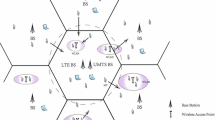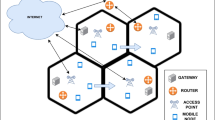Abstract
In Media Independent Handover (MIH), Call Admission Control (CAC) and Vertical Handoff (VH) are two important mechanisms in a Mobile Wireless Networks (MWNs) that consists of various types of wireless networks (e.g., WiMAX and WiFi) and cellular communications (e.g., 3G, 3.5G and 4G). First, an adaptive CAC is needed in base stations for achieving high network reward while guaranteeing QoS requirements. Second, an efficient vertical handoff enables mobile stations accomplishing seamless, fast, QoS-aware mobility in MWNs. In CAC, several studies have proposed the mechanisms: the static resource reservation-based, bandwidth borrow-based and Markov chain model-based approaches. They suffer from moderate performance in Grade of Service (GoS), Fractional Reward Loss (FRL) and transmission quality. In VH, it should consider both the received signal strength (RSS) and the service-class mapping between the serving and target networks. Most studies adopted the integration of a RSS-based method with hysteresis to minimize unnecessary handoffs, but high handoff dropping and low network utilization limit the contributions. This work thus proposes a MIH-based competitive on-line (COL) CAC for vertical handoff in a loosely-coupled MWN. First, in a base station (BS) the COL CAC models the resource occupancy of each wireless network in a MWN as a Markov chain model, and then forms a cost-reward CAC for maximizing network reward. Second, in MS the VH scheme adopts a predictive RSS to predict the moving trend of each mobile station to select the optimal target network. Numerical results indicate that the proposed approach outperforms other approaches in GoS, FRL and the number of vertical handoffs while yielding competitive utilization.
Similar content being viewed by others
References
Lampropoulos, G., Salkintzis, A. K., & Passas N. (Jan. 2008). Media-independent handover for seamless service provision in heterogeneous networks. IEEE Communications Magazine, 64–71.
IEEE Standard for Local and Metropolitan Area Networks Part 16: Air Interface for Fixed Broadband Wireless Access Systems, IEEE 802.16e Standard, (Feb. 2006).
IEEE Standard for Local and Metropolitan Area Networks Part 11: Wireless LAN Medium Access Control (MAC) and Physical Layer (PHY) Specifications, IEEE 802.11e Standard, (Nov. 2005).
Holma H., Toskala A. (2004) WCDMA for UMTS: Radio access for third generation mobile communications. Wiley, London
Holma H., Toskala A. (2006) HSDPA/HSUPA for UMTS: High speed radio access for mobile communications. Wiley, London
LTE/LTE-Advanced; http://www.3gpp.org/ftp/Specs/html-info/36-series.htm.
Lai W. K., Chiu J. C. (2005) Improving handoff performance in wireless overlay networks by switching between two-layer IPv6 and one-layer IPv6 addressing. Selected Areas in Communications 23(11): 2129–2137
Ali, S., Fakoorian, A., & Taheri, H. (Jan. 2006). Protection of originating calls in handoff prioritization schemes. In Wireless Pervasive Computing, 2006 1st International Symposium on 16–18 (pp. 6).
Candan I., Salamah M. (2007) Analytical modeling of a time-threshold based bandwidth allocation scheme for cellular networks. Computer Communications 30(5): 1036–1043
Katzela I., Naghshineh M. (1996) Channel assignment schemes for cellular mobile telecommunication systems: A comprehensive survey. Personal Communications 3(3): 10–30
Ogbonmwan S. E., Li W., Kazakos D. (2005) Multi-threshold bandwidth reservation scheme of an integrated voice/data wireless network. Wireless Networks, Communications and Mobile Computing 1: 226–231
Salamah M., Lababidi H. (2005) Dynamically adaptive channel reservation scheme for cellular networks. Computer Networks 49(6): 787–796
Weia Y., Lina C., Rena F., Raadb R., Dutkiewiczb E. (2004) Dynamic handoff scheme in differentiated QoS wireless multimedia networks. Computer Communications 27(10): 1001–1011
Zhang J., Mark J. W., Shen X. (2005) An adaptive handoff priority scheme for wireless MC-CDMA cellular networks supporting realtime multimedia applications. Computer Communications 28(10): 1240–1250
Lu N., Bigham J. (2007) On utility-fair bandwidth adaptation for multi-class traffic QoS provisioning in wireless networks. Computer Networks 51(10): 2554–2564
Roberto J., Marca B., Priolli L. B. (2006) Organizing reserve channels for superior admission control performance. IEEE Transactions of Wireless Communications 5(1): 52–56
Yee Y. C., Choong K. N., Low A. L. Y., Tan S. W., Chien S. F. (2007) A conservative approach to adaptive call admission control for QoS provisioning in multimedia wireless networks. Computer Communications 30(2): 249–260
Mosharaf K., Lambadaris I., Talim J. (2005) A call admission control for service differentiation and fairness management in WDM grooming networks. Optical Switching and Networking 2(2): 113–126
Stevens-Navarro, E., Lin, Y., & Wong, V. (2007). An MDP-based vertical handoff decision algorithm for heterogeneous wireless networks. IEEE Transactions on Vehicular Technology, 2, 1.
Chen M.-X., Chang B.-J., Hwang R.-H., Juang J.-F. (2004) MDP-based OVSF code assignment scheme and call admission control for wideband-CDMA communications. Computers and Communications 2: 672–677
Zhao Q., Tsang D. H. K., Sakurai T. (2010) A novel CAC scheme for homogeneous 802.11 networks. IEEE Transactions on Wireless Communications 9(3): 1168–1174
Stratogiannis D. G., Tsiropoulos G. I., Kanellopoulos J. D., Cottis P. G. (2009) Probabilistic call admission control in wireless multiservice networks. IEEE Communications Letters 13(10): 746–748
Bing H., He C., Jiang L. (2003) Performance analysis of vertical handover in a UMTS-WLAN integrated network. IEEE International Symposium on Personal, Indoor and Mobile Radio Communications 2003(1): 187–191
Marichamy P., Chakrabarti S., Maskara S. L. (2003) Performance evaluation of handoff detection schemes. IEEE Conference on Convergent Technologies For The Asia-Pacific 2003 2: 643–646
Pahlavan K., Krishnamurthy P., Hatami A., Ylianttila M., Makela J.P., Pichna R. et al (2000) Handoff in hybrid mobile data networks. IEEE Personal Communications 7(2): 34–47
Pollini G. P. (1996) Trends in handover design. IEEE Communications Magazine 34(3): 82–90
Zhang N., Holtzman J. M. (1996) Analysis of handoff algorithms using both absolute and relative measurements. IEEE Transactions on Vehicular Technology 45(1): 174–179
Fang Z., McNair J. (2004) Optimizations for vertical handoff decision algorithms. IEEE Wireless Communications and Networking Conference 2: 867–872
McNair J., Fang Z. (2004) Vertical handoffs in fourth-generation multinetwork environments. IEEE Wireless Communications 11(3): 8–15
Wang, H. J., Katz, R. H., & Giese, J. (Feb. 1999). Policy-enabled handoffs across heterogeneous wireless networks. InIEEE Mobile Computing Systems and Applications Conference (pp. 51–60).
Guo C., Guo Z., Zhang Q., Zhu W. (2004) A seamless and proactive end-to-end mobility solution for roaming across heterogeneous wireless networks. IEEE Journal on Selected Areas in Communications 22(5): 834–848
Zhang Q., Guo C., Guo Z., Zhu W. (2003) Efficient mobility management for vertical handoff between WWAN and WLAN. IEEE Communications Magazine 41(11): 102–108
Chang B.-J., Chen J.-F. (2008) Cross layer-based adaptive vertical handoff with predictive RSS in heterogeneous wireless networks. IEEE Transactions on Vehicular Technology 57(6): 3679–3692
Shi Y., Hou Y. T., Zhou H. i. (2009) Per-node based optimal power control for multi-hop cognitive radio networks. IEEE Transactions on Wireless Communications 8(10): 5290–5299
Cho J.-W., Mo J., Chong S. (2009) Joint network-wide opportunistic scheduling and power control in multi-cell networks. IEEE Transactions on Wireless Communications 8(3): 1520–1531
Hasna M. O., Alouini M.-S. (2002) Optimum power allocation for soft handoff algorithms over lognormal shadowing channels. IEEE International Conference on Communications 5: 3207–3211
Akar M. (2006) Optimal power and handoff control for CDMA wireless networks. IEEE International Conference on Communications 11: 4918–4923
Liao C.-Y., Chang C.-J., Wang L.-C., Chen Y.-S. (2007) A joint power and rate assignment algorithm for multirate soft handoffs in mixed-size WCDMA cellular systems. IEEE Transactions on Vehicular Technology 56(3): 1388–1398
Chang B.-J. (2008) Reliable distributed local repair approach for maximizing reliability and packet delivery rate in wireless on demand AODV networks. Wireless Personal Communications 45(1): 11–30
Boumerdassi S., Beylot A.-L. (1999) Adaptive channel allocation for wireless PCN. Mobile Networks and Applications 4(2): 111–116
Johnson, D., Perkins, C., & Arkko, J. (June 2004). Mobility support in IPv6, IETF RFC 3775.
Hwang, R.-H., Hsiao, W.-C., & Chang, B.-J. (Feb. 2004). Multiple classes of QoS guarantee in distributed Multicast routing. In The 6th International Conference on Advanced Communication Technology (Vol. 2, pp. 949–954).
Chang B.-J., Chen Y.-L. (2008) Adaptive hierarchical Polling and Markov decision process based call admission control for minimizing Polling delay and increasing network reward in IEEE 802.16 WiMAX networks. Computer Communications 31(10): 2280–2292
Gawlick, R., Kamath, A., Plotkin, S., & Ramarkrishnan, K. (1995). Routing and admission control in general topology networks. Technical report STAN-CS-TR-95-1548, Stanford University.
Howard R. A. (1960) Dynamic programming and Markov processes. Wiley, London
Allan B., El-Yaniv R. (1998) Online computation and competitive analysis. Cambridge University Press, Cambridge
Zhang, L., Andrews, M., Aielo, W., Bhatt, S., & Krishnan, K. R. (Nov. 1997). A performance comparison of competitive on-line routing and state-dependent routing. In GLOBECOM’97 (pp. 1813–1819).
Chung, S.-P., & Ross, K. W. (1993). Reduced load approximations for multirate loss networks. IEEE Transactions on Communications, 41(8).
Wilkinson R. I. (1956) Theories of toll traffic engineering in the USA. Bell System Technical Journal 40: 421–514
Ali R. B., Pierre S. (2008) On the impact of mobility and soft vertical handoff on voice admission control in loosely coupled 3G/WLAN networks. IEEE Communications Letters 13(5): 303–305
Chang T.-C., Wen K.-L., You M.-L. (1998) The study of regression based on grey system theory. IEEE International Conference on Systems, Man, and Cybernetics 5: 4307–4311
Chapra S. C., Canale R. P. (2002) Numerical methods for engineers. McGraw-Hill, New York
Chang B.-J., Lin S.-Y. (2006) Mobile IPv6-based efficient vertical handoff approach for heterogeneous wireless networks. Wiley Wireless Communications and Mobile Computing 6(5): 691–709
Lee D., Choi J.-G., Joo C., Bahk S. (2008) Hierarchical Markov chain analysis of an adaptive bandwidth reservation algorithm in wireless communication systems. Performance Evaluation 65: 573–585
AlQahtani S. A., Mahmoud A. S. (2008) Performance analysis of two throughput-based call admission control schemes for 3G WCDMA wireless networks supporting multiservices. Computer Communications 31(1): 49–57
The network simulator ns-2; http://www.isi.edu/nsnam/ns/.
Pahlavan K., Krishnamurthy P. (2001) Principles of wireless networks: A unified approach. Prentice Hall PTR, Englewood Cliffs
Author information
Authors and Affiliations
Corresponding author
Rights and permissions
About this article
Cite this article
Liang, YH., Chang, BJ. & Chen, CT. Media Independent Handover-based Competitive On-Line CAC for Seamless Mobile Wireless Networks. Wireless Pers Commun 67, 199–225 (2012). https://doi.org/10.1007/s11277-011-0373-9
Published:
Issue Date:
DOI: https://doi.org/10.1007/s11277-011-0373-9




